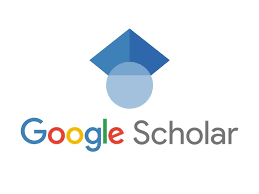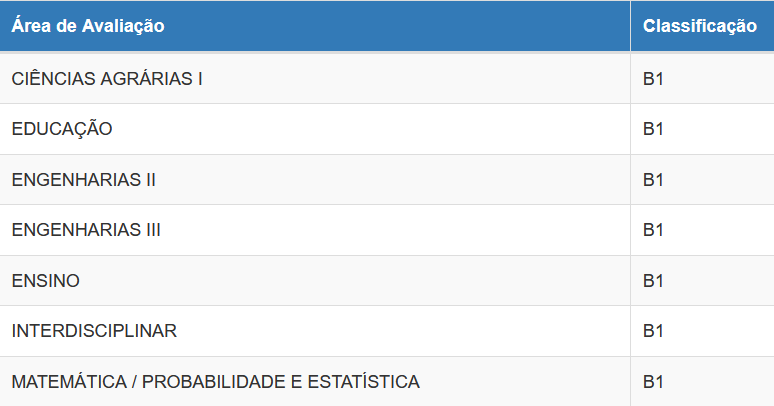About the Journal
Focus and scope
REMAT's mission is to share research in the areas of Mathematics Education and Mathematics. The journal aims at publishing and disseminating original productions by professors and researchers.
Sections
1. Mathematics Education
Articles that present original results, partial or final, of scientific research in the area of Mathematical Education, related to the Teaching of Mathematics and to the Initial or Continued Formation of Mathematics Teachers at the most diverse levels and modalities.
2. Mathematics
Articles that present original results, partial or final, of scientific research in the area of Applied Mathematics, with interfaces in other Sciences, in the most different contexts, including technical and technological. And, in the area of Pure Mathematics, in addition to original, partial or final results of scientific research, articles on mathematical dissemination that present a new perspective on Mathematics problems or topics that are absent, in general, in Mathematics courses.
Editorial Process
Manuscripts are initially assessed by the Editor-in-Chief as to suitability to the journal's focus, scope, section and standards, in accordance with the Guidelines for Authors. Manuscripts that do not meet the focus and scope of the journal are rejected. In case of other inconsistencies, a backlog is sent to the corresponding author, suggesting adjustments. If the author does not return within the stipulated period, the submission is archived.
The Editor-in-Chief assigns the submissions to the Section Editors, according to their areas of activity, for the evaluation process.
The Section Editor verifies the adequacy of the manuscript to the focus, scope, section of the journal and analyzes plagiarism and self-plagiarism issues, using the CopySpider tool. At this stage, adjustments can be requested from the corresponding author or the manuscript can be rejected.
After these verifications, the manuscripts submitted to REMAT are evaluated by at least two Ad Hoc Reviewers, designated according to their area of interest, coming from an institution different from that of the authors, in a double-blind process, in which the manuscripts are analyzed in relation to to the following aspects:
- Is the theme chosen by the author inserted in the area of study in which he/she is located?
- Does the summary show the scope of the research, its main objectives, the theoretical-methodological framework, results and conclusions, enabling the reader to broadly understand what is discussed in the text?
- Are the objectives of the study presented in the text and are they articulated in order to contribute to the scope proposed by the author?
- Does the article present a methodological characterization, materials and methods used in the study in such a way as to contribute to the construction and subsequent analysis of the data?
- Are the study results presented and discussed in an articulated manner with the theoretical and methodological references outlined in the text?
- Is it possible, through reading the text, to verify coherence and articulation between the theorization used by the author and the ideas developed by him?
- Are there references that can be indicated to the author to collaborate in the construction of the article's content?
- Are there excerpts with copyright infringement?
The Ad Hoc Evaluator fills in an opinion form directed to the Section Editor accepting, rejecting or recommending necessary corrections and/or adjustments. Each evaluator has a period of fourteen (14) days to carry out the evaluation.
In the case of requesting changes to the manuscript, this is forwarded to the corresponding author so that he can make the requested corrections within fifteen (15) calendar days, when he must resubmit the manuscript with the changes. If the manuscript is not resubmitted within the specified period, the submission is archived.
The peer review process preserves the identity of the authors and their affiliations, as well as the Ad Hoc Reviewers. The choice of Evaluators is carried out according to the analysis of the Evaluator's curriculum and areas of interest.
To be part of our body of Ad Hoc Evaluators, it is necessary to have a master's degree, be trained in Mathematics or related areas and have expertise in the REMAT area of activity in which your evaluation is being requested, proven through the curriculum Lattes or from ORCID. Foreign evaluators, who do not have Lattes or ORCID, must send another form of curriculum for analysis.
For the final opinion, the Section Editors can also consult the members of REMAT's Editorial Advisory Board, whose function is to guarantee the quality and scientific rigor of what is published in the journal.
The editorial decision is then communicated by the Section Editor to the corresponding author.
In case of identification of plagiarism in the article, at any stage of the process, the manuscript is rejected and the submission is archived. Plagiarism is considered a crime of violation of copyright provided for in the Brazilian Penal Code and Law No. 9,610.
Citation types, according to ABNT NBR 10520 (2002):
- Direct quote: Transcription of part of the author's work consulted.
- Indirect quote: Text based on the author's work consulted.
- Citation: Citation, direct or indirect, of a text in which the original was not accessed.
In the case of the use of own ideas already published, which are extremely important in the article submitted, the REMAT Editorial Commission allows up to three (3) self-citations.
REMAT publishes only unpublished articles that are not under review in any other scientific journal. If a publication or simultaneous submission to another journal is identified, the article is disregarded by the editors.
After approval, the manuscript undergoes a linguistic revision carried out by the Text Reviewers. Linguistic proofreading is carried out by proofreaders with a degree in Literature and specialists in English and Spanish. Each Reviewer has fourteen (14) days to respond to the request. The corresponding author makes the requested adjustments within seven (7) days, and the manuscript is forwarded to Layout Editing. At this stage, the manuscript is again checked for plagiarism with the iThenticate tool. The author has 24 hours to carry out the Proof Reading. If there is no response from the author at this stage, the manuscript is automatically forwarded for publication.
No additions or modifications to the text are allowed after final approval.
Each author may publish a maximum of one article per issue.
At least one of the authors, upon submission of the manuscript, must have a master's degree.
The time for completing an evaluation, considering the submission date and the acceptance date, must not exceed six (6) months.
REMAT's Editorial Process Flowchart

Declaration of Conflict of Interests, Originality, Unpublishedness and Authorship
The corresponding author must submit, together with the manuscript, the Declaration of Conflict of Interests, Originality, Unpublishedness and Authorship (PDF format, DOCX format), completed and signed by all authors. The authors assume public responsibility for its content, declare that the manuscript is original and unpublished and has not been submitted to another journal. They also declare their agreement with the Editorial Process, Guidelines for Authors and Declaration of Copyright, which will apply in case of publication of the manuscript, aware that each author may have a maximum of one article published per edition and that at least one of the authors has the title of master.
REMAT adopts the CRediT (Contributor Roles Taxonomy) specification system, maintained by the Consortia for Advancing Standards in Research Administration Information (CASRAI), in order to promote transparency regarding the individual contributions of authors in published articles. The CRediT system allows multiple forms of authorship or contribution to be attributed to a single author, namely: project administration, formal analysis, conceptualization, data curation, writing - first draft, writing - review and editing, research, methodology, obtaining funding, resources, software, supervision, validation and visualization. Regardless of the authors' contribution form, all are equally responsible for the article.
Frequency
REMAT adopts the publication system in continuous flow (rolling pass), being organized in two annual issues.
Open Access Policy
This magazine offers immediate free access to its content, following the principle that making scientific knowledge freely available to the public provides greater worldwide democratization of knowledge.
Publishing System
The journal uses Open Journal Systems (OJS 3.3.0.7), a free open source system for managing and publishing journals, developed with support and distribution by the Public Knowledge Project (PKP) under the GNU General Public License.
Digital Preservation Policy
REMAT is hosted on the IFRS Journal Portal, which guarantees the preservation of its digital content based on backup copies periodically made by the IFRS, in addition to the Portal being part of the Journal Portals Preserved by the Brazilian Network of Digital Preservation Services ( Carinian Network). As an initiative of the Brazilian Institute of Information in Science and Technology (IBICT), the Cariniana Network is part of the Lots of Copies Keep Stuff Safe (LOCKSS) program at Stanford University, USA, which provides free digital preservation software for libraries and publishers, with a view to preserving permanent and original digital content, as well as guaranteeing access to these collections.
Support Sources
Pró-reitoria de Pesquisa, Pós-graduação e Inovação - PROPPI/IFRS
Indexing Sources
Diadorim - Diretório de Políticas Editoriais das Revistas Científicas Brasileiras
Portal Brasileiro de Publicações Científicas em Acesso Aberto - oasisbr
LivRe - Revistas de Livre Acesso
Sumarios.org - Sumários de Revistas Brasileiras (até março de 2023)
DOAJ - Directory of Open Access Journals
RCAAP - Repositório Científico de Acesso Aberto de Portugal
MIAR - Information Matrix for the Analysis of Journals
BASE - Bielefeld Academic Search Engine
Journal History
REMAT began in 2015, with a group of teachers from the Caxias do Sul Campus of the Federal Institute of Education, Science and Technology of Rio Grande do Sul (IFRS), with the role of publicizing original productions focusing on Teaching Mathematics, Mathematics Applied and/or Pure Mathematics, as well as disseminating research that dealt with the use of digital technologies and their contributions to these fields of knowledge.
Two editions were published in 2015. The first one is totally linked to the Academic Week of the Degree in Mathematics Course at Campus Caxias do Sul of IFRS, published in September 2015, and the second with articles from different educational institutions, published in January 2016.
In 2016, REMAT began to present a special section dedicated to Applied Mathematics in Federal Institutes, both in terms of scientific research and in terms of teaching practices developed in technical, undergraduate and graduate courses. In the same year, it was indexed by Google Scholar and Diadorim.
From the end of 2016, the Editorial Team was restructured and expanded, with the purpose of promoting a better qualification of the journal. In addition, the sections were restructured, becoming: Mathematics in Technical and/or Technological Contexts, Mathematics Teaching and Pure and/or Applied Mathematics.
In 2018 it was indexed by Google Analytics, Brazilian Institute of Information in Science and Technology – ibict oasisbr, Free Access Journals – LivRe, Brazilian Journal Summaries – sumários.org and Directory of open access journals – DOAJ.
In 2019, it was indexed by the CAPES Journal Portal and the Directory of the Latindex System: Regional Information System on Line for Scientific Journals from Latin America, the Caribbean, Spain and Portugal.
REMAT started to adopt in 2020 the model of publications in continuous flow, whose main characteristic is the faster availability of research for readings and citations.
In 2021, REMAT articles began to be published in two sections: Mathematics Education, composed of articles that present original, partial or final results of scientific research in the area of Mathematics Education, related to Mathematics Teaching and Initial or Continuity of Mathematics Teachers in the most diverse levels and modalities, and Mathematics, composed of articles that present original, partial or final results, of scientific research in the area of Applied Mathematics, with interfaces in other Sciences, in the most different contexts, including technical and technological. And, in the area of Pure Mathematics, in addition to original, partial or final results of scientific research, mathematical dissemination articles that present a new perspective for Mathematics problems or topics absent, in general, in Mathematics courses.
REMAT's history can also be seen in the publications of its editors:
- From inspiration to the REMAT project: a collaborative and cooperative journey towards scientific dialogue. DOI: http://dx.doi.org/10.21452/wec.IXwec.2016.0005
- Reflections on emerging contemporary issues: digital accessibility at REMAT - Electronic Magazine of Mathematics. DOI: http://dx.doi.org/10.21452/abecmeeting.2017.002
- Actions developed at REMAT: Electronic Magazine of Mathematics with a view to digital accessibility. DOI: https://doi.org/10.21452/23580763.2018.5ne.77-85
- Implementation of Google Analytics at REMAT and analysis of user profiles. DOI: http://dx.doi.org/10.21452/abecmeeting.2018.164
- REMAT: analysis of the profile of its users through the Google Analytics tool and
dissemination of scientific knowledge among Mathematics teachers and students. DOI: https://doi.org/10.21452/23580763.2019.6ne.48-61 - REMAT: perspectives on migration to Open Journal Systems 3. DOI: http://dx.doi.org/10.21452/abecmeeting.2019.217
- REMAT and the editorial management of 2019: from the expansion of indexers to publication in continuous flow.
DOI: http://dx.doi.org/10.28998/cirev.2020.7ne.37-46 - Continuous publication and Creative Commons License: operational advances in REMAT's editorial practice with a view to Open Science. DOI: http://dx.doi.org/10.21452/abecmeeting2020.06
- Verification of similarity and author contribution in REMAT: iThenticate and CRediT. DOI: https://doi.org/10.21452/abecmeeting2021.35
Egresses Editors
Dr. Rene Carlos Cardoso Baltazar Júnior - Editor da Seção Matemática de Abril/2019 a Abril de 2023
Dr. Claus Haetinger - Editor Convidado de Fevereiro/2020 a Janeiro 2021
Dr. Nicolau Matiel Lunardi Diehl - Editor da Seção Matemática Pura e/ou Aplicada de Setembro/2015 a Agosto/2020
Dr. Rodrigo Sychocki da Silva - Editor da Seção Ensino de Matemática de Setembro/2015 a Julho/2020
































